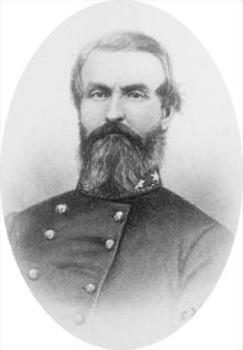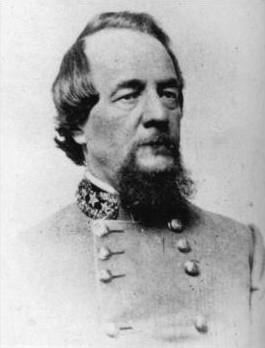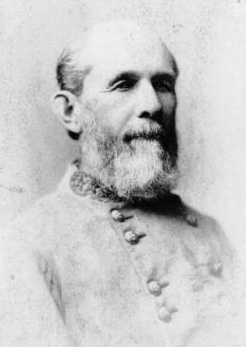The American Civil War bibliography comprises books that deal in large part with the American Civil War. There are over 60,000 books on the war, with more appearing each month. [1] There is no complete bibliography to the war; the largest guide to books is over 40 years old and lists over 6,000 titles. [2]
Note: This article forms part of Bibliography of the American Civil War

The Army of the Potomac was the primary field army of the Union Army in the Eastern Theater of the American Civil War. It was created in July 1861 shortly after the First Battle of Bull Run and was disbanded in June 1865 following the surrender of the Confederate Army of Northern Virginia in April.

Wade Hampton III was an American military officer who joined the Confederate States of America in rebellion against the United States of America during the American Civil War. He later had a career as a South Carolina politician. Hampton came from a wealthy planter family. Shortly before the war, he was both one of the largest enslavers in the Southeastern United States and a state legislator. During the American Civil War, he joined the Confederate cavalry, where he was a lieutenant general.

Paul Jones Semmes was a banker, businessman, and a Confederate brigadier general during the American Civil War. He was mortally wounded at the Battle of Gettysburg.

Edward "Allegheny" Johnson was a United States Army officer and Confederate general in the American Civil War. Highly rated by Robert E. Lee, he was made a divisional commander under Richard S. Ewell. On the first evening of the Battle of Gettysburg, Ewell missed his opportunity to attack Cemetery Hill, and Johnson opted against attacking Culp's Hill, for which he had a discretionary order, though he attempted this on the second and third days. Ewell and Johnson are blamed by many for the loss of this decisive battle.

James Johnston Pettigrew was an American author, lawyer, and soldier. He served in the army of the Confederate States of America, fighting in the 1862 Peninsula Campaign and played a prominent role in the Battle of Gettysburg. Despite starting the Gettysburg Campaign commanding a brigade, Pettigrew took over command of his division after the division's original commander, Henry Heth, was wounded. In this role, Pettigrew was one of three division commanders in the disastrous assault known as Pickett's Charge on the final day of Gettysburg. He was wounded, in the right hand, during the Pickett-Pettigrew Charge on July 3, 1863 and was later mortally wounded during the Union Confederate rearguard action while the Confederates retreated to Virginia near Falling Waters, Virginia on July 14, dying several days thereafter on July 17, 1863.

Samuel Wylie Crawford was a United States Army surgeon and a Union general in the American Civil War.

Alfred Iverson Jr. was a lawyer, an officer in the Mexican–American War, a U.S. Army cavalry officer, and a Confederate general in the American Civil War. He served in the 1862–63 campaigns of the Army of Northern Virginia as a regimental and later brigade commander. His career was fatally damaged by a disastrous infantry assault at the first day of the Battle of Gettysburg. General Robert E. Lee removed Iverson from his army and sent him to cavalry duty in Georgia. During the Atlanta Campaign, he achieved a notable success in a cavalry action near Macon, Georgia, capturing Union Army Maj. Gen. George Stoneman and hundreds of his men.
The Battle of Hunterstown was an American Civil War skirmish at Beaverdam Creek near Hunterstown, Pennsylvania, on July 2, 1863, in which Wade Hampton's Confederate cavalry withdrew after engaging George Armstrong Custer's and Elon Farnsworth's Union cavalry.

William "Extra Billy" Smith was a lawyer, congressman, the 30th and 35th Governor of Virginia, and a major general in the Confederate States Army during the American Civil War. On his appointment in January 1863, at 65, Smith was the oldest Confederate general to hold field command in the war.

Rufus Clay Barringer was a North Carolina lawyer, politician, and Confederate brigadier general during the American Civil War.
James Jay Archer was a lawyer and an officer in the United States Army during the Mexican–American War. He later served as a brigadier general in the Confederate States Army (CSA) during the American Civil War.

Albert Gallatin Jenkins was an American attorney, planter, politician and military officer who fought for the Confederate States of America during the American Civil War. He served in the United States Congress and later the First Confederate Congress. After Virginia's secession from the Union, Jenkins raised a company of partisan rangers and rose to become a brigadier general in the Confederate States Army, commanding a brigade of cavalry. Wounded at the Battle of Gettysburg and again during the Confederate defeat at the Battle of Cloyd's Mountain, during which he was captured, Jenkins died just 12 days after his arm was amputated by Union Army surgeons as he was unable to recover. His former home is now operated by the United States Army Corps of Engineers.

William Tatum Wofford was an officer during the Mexican–American War and a general in the Confederate States Army during the American Civil War.
The American Civil War bibliography comprises books that deal in large part with the American Civil War. There are over 60,000 books on the war, with more appearing each month. Authors James Lincoln Collier and Christopher Collier stated in 2012, "No event in American history has been so thoroughly studied, not merely by historians, but by tens of thousands of other Americans who have made the war their hobby. Perhaps a hundred thousand books have been published about the Civil War."
A. P. Hill's Light Division was an infantry division in General Robert E. Lee's Confederate Army of Northern Virginia during the American Civil War. Originally including six brigades, the division's first commander starting May 27, 1862 was then Major General A. P. Hill. Major Generals William Dorsey Pender and Cadmus M. Wilcox commanded a reorganized Light Division in the Army of Northern Virginia after Hill's promotion to corps command and Pender's death at the Battle of Gettysburg, respectively.
Blakely rifle or Blakely gun is the name of a series of rifled muzzle-loading cannon designed by British army officer Captain Theophilus Alexander Blakely in the 1850s and 1860s. Blakely was a pioneer in the banding and rifling of cannon but the British army declined to use Blakely's design. The guns were mostly sold to Russia and the Confederacy during the American Civil War. Blakely rifles were imported by the Confederacy in larger numbers than other Imported English cannon. The State of Massachusetts bought eight 9 in (23 cm) and four 11 in (28 cm) models.

The 28th Virginia Infantry Regiment was an infantry regiment raised in Virginia for service in the Confederate States Army during the American Civil War. It fought mostly with the Army of Northern Virginia. The 28th Virginia completed its organization at Lynchburg, Virginia, in June, 1861. Its members were raised in the counties of Botetourt, Craig, Bedford, Campbell, and Roanoke.
Henry Brainerd McClellan was an officer and adjutant general in the Confederate States Army during the American Civil War, a teacher and author. He was a professor at Sayre Female Institute in Lexington, Kentucky for 35 years after the war.
The following list is a bibliography of American Civil War Confederate military unit histories and are generally available through inter-library loan. More details on each book are available at WorldCat. For an overall national view, see Bibliography of the American Civil War. For histories of the Union, see Bibliography of American Civil War Union military unit histories. For a guide to web sources see: Carter, Alice E.; Jensen, Richard. The Civil War on the Web: A Guide to the Very Best Sites—Completely Revised and Updated (2003).
Eric J. Wittenberg is an American Civil War historian, author, lecturer, tour guide and battlefield preservationist. He is a practicing attorney in downtown Columbus, Ohio. His published works have focused especially on the Civil War cavalryman and the cavalry battles of the Civil War, with emphasis on the Army of the Potomac's Cavalry Corps. His first book, Gettysburg's Forgotten Cavalry Actions, was chosen as the best new work addressing the Battle of Gettysburg in 1998, winning the Robert E. Lee Civil War Roundtable of Central New Jersey's Bachelder-Coddington Award. The second edition of this book, published in 2011, won the U. S. Army Historical Foundation's Distinguished Writing Award for that year's best reprint. In 2015, his book The Devil's to Pay: John Buford at Gettysburg won the Gettysburg Civil War Roundtable's 2015 Book Award. He was a member of the Governor of Ohio’s Advisory Commission on the Sesquicentennial of the Civil War and has been active with several Civil War battlefield preservation organizations. He and his wife Susan Skilken Wittenberg reside on the east side of Columbus, Ohio.